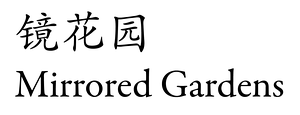The Mind of Things
November 3, 2019–February 29, 2020
Hualong Agriculture Grand View Garden
Panyu District
Guangzhou
China
Hours: Wednesday–Sunday 11am–5pm
mail@mirroredgardens.art
Buntings appear in our daily life, yet we don’t think of them even if we run into them every day. The buntings seem to act on our subtle sensations, generating no ideal, validating no will, not constituting happiness itself, nor producing any happiness. It cannot be defined nor memorized, but just as Unspeakable Happiness 3 implies, a bunting has its own specific color and shape in various spaces and contexts, causing the shapes of our own feelings to clearly emerge in front of us.
In Chu Yun’s works, there is an inner silence that invites its viewer—one of our human race—to stay with it, waiting for the coming of a moment when he is able to reflect on his own sensual feelings. This silence, on the one hand, relates to the relationship between human beings and things being beyond words, with all subjective expressions becoming rather conceited; on the other hand, it has something to do with the works carrying time within themselves, such that at a certain moment the sensations of a human being and the existence of things reach to their meeting point, only until then may the works enter the journey of our life by way of its own existence.
The Image of Numbers seems to have returned to the direct relationship between the passage of time itself and our sensual experiences. In the artist’s repeated recitation, each of the numbers from 10 to 0 continuously enters our minds one after another, and our sense of hearing begins to shape the images of these numbers while we are listening to his recitation; it is like: at any time when we hear the story of someone, we are set to conceive his images in our mind. As a form of existence abstracted from time and space, numbers are able to return to our bodies and breaths, moving towards the basic conditions for our being. It is exactly because of these conditions involving time and space that people are able to experience their own lives and explore the possibility of “living together” with each other.
Therefore, Chu Yun regards the exhibition space, which an artist has to face, as a space with “potentials” that returns to one’s sensory reality. It is a space that can make some “common moments” previously torn apart to be renewed through the encounters between individuals and the works. In such a space, things themselves meet human senses, bringing out inspirations originated from their own nature without offering any promise to satisfy people’s desires. For instance, the moment preserved on the card in An Ordinary Moment is a moment we captured when we encounter the work in this time and space. It is not a moment of creating a miracle, nor a moment of entering into a crazy venture. It operates outside of the time in our excessive economic life, and because it is ordinary, it falls out of our usual range of perception.
This “realistic circle” distinctly appeared on the wall, and it appeared in the space embracing our bodies. It is no longer a circle as a concept, nor an analog to or a symbol of a circle. It is a circle that can be directly felt in the reality of our senses. We are in front of this circle, and at the same time, we are in the real time and space where this circle appears. Starting from this circle in the sensory reality, we may be able to move closer to the ethics embedded in the circle, and to ponder what is the relevance between a circle in the reality and the reality itself that is full of contradictions.
About Chu Yun
Born in 1977 in Ji’an, Jiangxi province, Chu Yun lives in Beijing. Chu Yun’s solo exhibitions include Chu Yun, Portikus, Frankfurt am Main, 2009; Chu Yun: Smile of the Matter, Vitamin Creative Space, Guangzhou, 2007. He has participated in international exhibitions and biennials, including Making Worlds, the 53rd Venice biennale, 2009; Generational: Younger Than Jesus, the first edition of the New Museum’s triennial, New York, 2009; China Power Station 2, Astrup Fearnley Museum of Modern Art, Oslo,2007; Beyond, The Second Guangzhou Triennial, Guangdong Museum of Art, Guangzhou, 2005.
About Mirrored Gardens
Inspired by the natural and traditional characteristics of the surrounding villages, the project space of Mirrored Gardens seeks to merge with its environment to construct a “nature,” where contemporary art practices, daily life and farming-oriented life practices can be nurtured and cultivated in tandem. The architecture of Mirrored Gardens is designed by Sou Fujimoto Architects.



